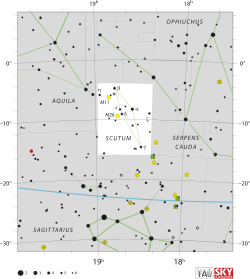Gamma Scuti
| Gamma Scuti (γ) | |
 | |
| Observationsdata Epok: J2000.0 | |
|---|---|
| Stjärnbild | Skölden |
| Rektascension | 18t 29m 11,85388s[1] |
| Deklination | -14° 33′ 56,9319″[1] |
| Skenbar magnitud () | +4,67[2] |
| Stjärntyp | |
| Spektraltyp | A2: V[3] |
| U–B | +0,04[4] |
| B–V | +0,07[4] |
| Astrometri | |
| Radialhastighet () | -41,00[5] km/s |
| Egenrörelse (µ) | RA: +3,22[1] mas/år Dek.: -4,02[1] mas/år |
| Parallax () | 10,21 ± 0,24[1] |
| Avstånd | 319 ± 8 lå (98 ± 2 pc) |
| Absolut magnitud () | -0,28[2] |
| Detaljer | |
| Massa | 2,91[6] M☉ |
| Radie | 4,1[7] R☉ |
| Luminositet | 150[6] L☉ |
| Temperatur | 9 016[6] K |
| Vinkelhastighet | 222[6] |
| Ålder | 237[8] miljoner år |
| Andra beteckningar | |
| γ Sct, BD−14° 5071, FK5 696, GC 25220, HD 170296, HIP 90595, HR 6930, SAO 161520, GSC 05702-02882 | |
Gamma Scuti (γ Scuti, förkortad Gamma Sct, γ Sct), som är stjärnans Bayer-beteckning, är en ensam stjärna[9] i sydvästra delen av stjärnbilden Skölden. Den har en skenbar magnitud av 4,67[2] och är synlig för blotta ögat där ljusföroreningar ej förekommer. Baserat på parallaxmätning inom Hipparcosuppdraget på ca 10,2 mas,[1] beräknas den befinna sig på ett avstånd av ca 320 ljusår (98 parsek) från solen.
Egenskaper[redigera | redigera wikitext]
Gamma Scuti är en blå till vit stjärna i huvudserien av spektralklass A2: V.[3] Den har en massa som är knappt 3[6]gånger solens massa, en radie som är ca 4[7] gånger solens radie och avger ca 150 [6] gånger mer energi än solen från dess fotosfär vid en effektiv temperatur på ca 9 000 K.[6]
Gamma Scuti roterar snabbt med en projicerad rotationshastighet på 222 km/s,[6] vilket ger stjärnan en något tillplattad form med en ekvatorialradie som uppskattas till att vara 21 procent större än polarradien.[10]
Referenser[redigera | redigera wikitext]
- Den här artikeln är helt eller delvis baserad på material från engelskspråkiga Wikipedia, 11 februari 2019.
Noter[redigera | redigera wikitext]
- ^ [a b c d e f] Van Leeuwen, F. (2007). "Validation of the new Hipparcos reduction". Astronomy and Astrophysics. 474 (2): 653. arXiv:0708.1752. Bibcode:2007A&A...474..653V. doi:10.1051/0004-6361:20078357. Vizier catalog entry
- ^ [a b c] Anderson, E.; Francis, Ch. (2012). "XHIP: An extended hipparcos compilation". Astronomy Letters. 38 (5): 331. arXiv:1108.4971. Bibcode:2012AstL...38..331A. doi:10.1134/S1063773712050015. Vizier catalog entry
- ^ [a b] Abt, Helmut A.; Morrell, Nidia I. (1995). "The Relation between Rotational Velocities and Spectral Peculiarities among A-Type Stars". Astrophysical Journal Supplement. 99: 135. Bibcode:1995ApJS...99..135A. doi:10.1086/192182.
- ^ [a b] Mallama, A. (2014). "Sloan Magnitudes for the Brightest Stars". The Journal of the American Association of Variable Star Observers. 42: 443. Bibcode:2014JAVSO..42..443M.Vizier catalog entry
- ^ Gontcharov, G. A. (2006). "Pulkovo Compilation of Radial Velocities for 35 495 Hipparcos stars in a common system". Astronomy Letters. 32 (11): 759. arXiv:1606.08053. Bibcode:2006AstL...32..759G. doi:10.1134/S1063773706110065.
- ^ [a b c d e f g h] Zorec, J.; Royer, F. (2012). "Rotational velocities of A-type stars". Astronomy & Astrophysics. 537: A120. arXiv:1201.2052. Bibcode:2012A&A...537A.120Z. doi:10.1051/0004-6361/201117691. Vizier catalog entry
- ^ [a b] Allende Prieto, C.; Lambert, D. L. (1999). "Fundamental parameters of nearby stars from the comparison with evolutionary calculations: Masses, radii and effective temperatures". Astronomy and Astrophysics. 352: 555. arXiv:astro-ph/9911002. Bibcode:1999A&A...352..555A. Vizier catalog entry
- ^ David, Trevor J.; Hillenbrand, Lynne A. (2015). "The Ages of Early-Type Stars: Strömgren Photometric Methods Calibrated, Validated, Tested, and Applied to Hosts and Prospective Hosts of Directly Imaged Exoplanets". The Astrophysical Journal. 804 (2): 146. arXiv:1501.03154. Bibcode:2015ApJ...804..146D. doi:10.1088/0004-637X/804/2/146. Vizier catalog entry
- ^ Eggleton, P. P.; Tokovinin, A. A. (September 2008), "A catalogue of multiplicity among bright stellar systems", Monthly Notices of the Royal Astronomical Society, 389 (2): 869–879, arXiv:0806.2878, Bibcode:2008MNRAS.389..869E, doi:10.1111/j.1365-2966.2008.13596.x.
- ^ van Belle, Gerard T. (March 2012), "Interferometric observations of rapidly rotating stars", The Astronomy and Astrophysics Review, 20 (1): 51, arXiv:1204.2572, Bibcode:2012A&ARv..20...51V, doi:10.1007/s00159-012-0051-2.
Externa länkar[redigera | redigera wikitext]
| ||||||||||||||||





